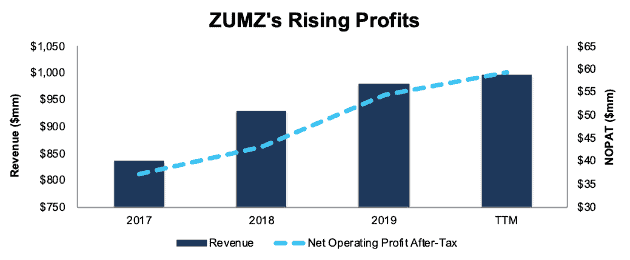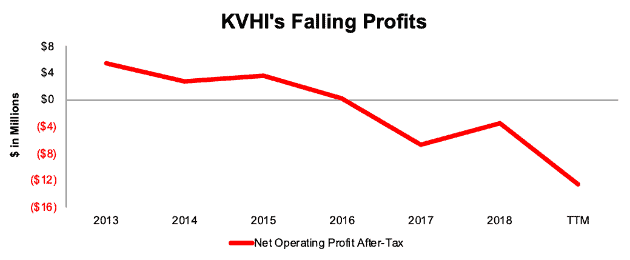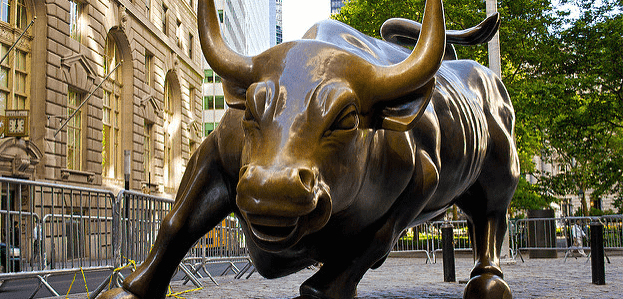Recap from October’s Picks
Our Most Attractive Stocks (+6.9%) outperformed the S&P 500 (+5.8%) from October 3, 2019 through November 4, 2019. The best performing large cap stock gained 23% and the best performing small cap stock was up 20%. Overall, 24 out of the 40 Most Attractive stocks outperformed the S&P 500.
Our Most Dangerous Stocks (+3.7%) outperformed the S&P 500 (+5.8%) as a short portfolio from October 3, 2019 through November 4, 2019. The best performing large cap stock fell by 11% and the best performing small cap stock fell by 22%. Overall, 27 out of the 40 Most Dangerous stocks outperformed the S&P 500 as shorts.
Only our research utilizes the superior data and earnings adjustments featured by the HBS & MIT Sloan paper, "Core Earnings: New Data and Evidence.” The successes of these model portfolios highlight the value of our machine learning and AI Robo-Analyst technology[1], which helps clients fulfill the fiduciary duty of care and make smarter investments[2].
14 new stocks make our Most Attractive list this month, and 13 new stocks fall onto the Most Dangerous list this month. November’s Most Attractive and Most Dangerous stocks were made available to members on November 6, 2019.
Our Most Attractive stocks have high and rising returns on invested capital (ROIC) and low price to economic book value ratios. Most Dangerous stocks have misleading earnings and long growth appreciation periods implied by their market valuations.
Most Attractive Stocks Feature for November: Zumiez Inc. (ZUMZ: $30/share)
Zumiez Inc. (ZUMZ) is the featured stock from November’s Most Attractive Stocks Model Portfolio.
Since 2017, ZUMZ’s revenue has grown by 8% compounded annually and after-tax profit (NOPAT) has grown by 21% compounded annually. ZUMZ’s trailing twelve month (TTM) NOPAT is up 21% over the prior TTM period as well. NOPAT margin has improved from 4.5% in 2017 to 5.9% TTM while its return on invested capital (ROIC) improved from 6% to 9% over the same time.
Figure 1: ZUMZ’s Revenue & NOPAT Since 2017

Sources: New Constructs, LLC and company filings
ZUMZ Valuation Offers Upside Potential
At its current price of $30/share, ZUMZ has a price-to-economic book value (PEBV) ratio of 0.9. This ratio means the market expects ZUMZ’s NOPAT to permanently decline by 10%. This expectation seems overly pessimistic for a firm that has grown NOPAT by 21% since 2017 and 8% compounded annually over the past decade.
If ZUMZ can maintain its 2019 NOPAT margin (6% - slightly below TTM margin) and grow NOPAT by just 3% compounded annually for the next decade, the stock is worth $39/share today – a 30% upside. See the math behind this reverse DCF scenario.
Critical Details Found in Financial Filings by Our Robo-Analyst Technology
As investors focus more on fundamental research, research automation technology is needed to analyze all the critical financial details in financial filings as shown in the Harvard Business School and MIT Sloan paper, "Core Earnings: New Data and Evidence”.
Below are specifics on the adjustments we make based on Robo-Analyst findings in Zumiez’s 2019 10-K:
Income Statement: we made $28 million of adjustments, with a net effect of removing $9 million in non-operating expenses (1% of revenue). You can see all the adjustments made to ZUMZ’s income statement here.
Balance Sheet: we made $473 million of adjustments to calculate invested capital with a net increase of $230 million. One of the largest adjustments was $326 million due to operating leases. This adjustment represented 74% of reported net assets. You can see all the adjustments made to ZUMZ’s balance sheet here.
Valuation: we made $468 million of adjustments with a net effect of decreasing shareholder value by $190 million. Apart from total debt, which includes the operating leases noted above, the largest adjustment to shareholder value was $139 million in excess cash. This adjustment represents 18% of ZUMZ’s market cap. See all adjustments to ZUMZ’s valuation here.
Most Dangerous Stocks Feature: KVH Industries (KVHI: $10/share)
KVH Industries, (KVHI) is the featured stock from November’s Most Dangerous Stocks Model Portfolio.
KVHI’s NOPAT has declined from $5 million in 2013 to -$13 million TTM, per Figure 2. NOPAT margin has fallen from 3% in 2013 to -8% TTM while ROIC fell from 4% to -6% over the same time.
Figure 2: KVHI’s NOPAT Since 2013

Sources: New Constructs, LLC and company filings
KVHI Provides Poor Risk/Reward
Despite its deteriorating fundamentals, KVHI is still priced for significant profit growth.
To justify its current price of $10/share, KVHI must achieve a NOPAT margin of 3% (last done in 2013, compared to -8% TTM) and grow revenue by 8% compounded annually for the next 12 years. See the math behind this reverse DCF scenario. This expectation seems overly optimistic given that KVHI’s revenue has fallen by 2% compounded annually since 2015 and its margin significantly declined over the past three years.
Even if we assume KVHI can achieve a 3% NOPAT margin and grow revenue by a more conservative 5% compounded annually for the next decade, the stock is worth only $6/share today – a 40% downside. See the math behind this reverse DCF scenario.
Critical Details Found in Financial Filings by Our Robo-Analyst Technology
As investors focus more on fundamental research, research automation technology is needed to analyze all the critical financial details in financial filings as shown in the Harvard Business School and MIT Sloan paper, "Core Earnings: New Data and Evidence”.
Below are specifics on the adjustments we make based on Robo-Analyst findings in KVH Industries’ 2018 10-K:
Income Statement: we made $7 million of adjustments, with a net effect of removing $5 million in non-operating expense (3% of revenue). You can see all the adjustments made to KVHI’s income statement here.
Balance Sheet: we made $136 million of adjustments to calculate invested capital with a net increase of $58 million. One of the largest adjustments was $68 million due to operating leases. This adjustment represented 52% of reported net assets. You can see all the adjustments made to KVHI’s balance sheet here.
Valuation: we made $119 million of adjustments with a net effect of decreasing shareholder value by $24 million. Apart from total debt, which includes the operating leases noted above, the largest adjustment to shareholder value was $47 million in excess cash. This adjustment represents 25% of KVHI’s market cap. See all adjustments to KVHI’s valuation here.
This article originally published on November 15, 2019.
Disclosure: David Trainer, Kyle Guske II, and Sam McBride receive no compensation to write about any specific stock, style, or theme.
Follow us on Twitter, Facebook, LinkedIn, and StockTwits for real-time alerts on all our research.
[1] Harvard Business School features the powerful impact of our research automation technology in the case New Constructs: Disrupting Fundamental Analysis with Robo-Analysts.
[2] This paper compares our analytics on a mega cap company to other major providers. The Appendix details exactly how we stack up.
